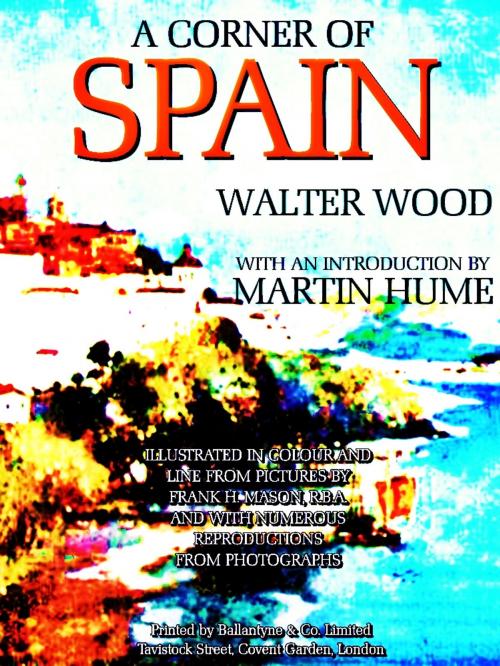A Corner of Spain (Illustrations)
Nonfiction, Travel, Europe, Spain & Portugal, History, European General| Author: | Walter Wood | ISBN: | 1230000313726 |
| Publisher: | Ballantyne & Co. Limited | Publication: | March 19, 2015 |
| Imprint: | Language: | English |
| Author: | Walter Wood |
| ISBN: | 1230000313726 |
| Publisher: | Ballantyne & Co. Limited |
| Publication: | March 19, 2015 |
| Imprint: | |
| Language: | English |
Example in this ebook
I stood upon the salient bastion of an ancient fortress towering high above a swift and placid river. Below and around me swept line upon line of crumbling walls and grass-grown moats, the scene of many a bloody struggle in the evil days of old. From a hundred grim embrasures peeped rusty cannon, harmless now, and dark-eyed children sported upon the battlements that once had belched defiance and destruction to the foe across the stream. For this old white town, cramped within its triple ramparts, is the last vantage ground of Portugal; and on the other side of the Miño straight before me is Galicia, the unconquered land of the Gael, a land of mountain and flood, of mist and sunlight, such as are all the western promontories in which the mysterious Celtic people have finally found a home after ages of unrecorded wanderings.
The scene as I looked upon it from these old battlements of Valença is as fair as any that Europe can offer. Down in the valley on both sides of the stream the maize-fields are reddening in the autumn sun, and between them, and terraced on the hill slopes above them, vines, heavy now with great masses of black grapes, are trained over slender posts of grey granite, forming endless arcades of fruit and foliage. Then higher up, climbing the steep skirts of the mountains, vast forests of darkling pines throw into relief the majestic summits, bare and boulder-strewn, upon which the ardent southern sunlight glows and quivers, whilst deep purple shadows fleck the tints of old rose and cinnamon where the sunlight falls. Across the majestic iron bridge that spans the Miño, the one modern note in all this scene, there rises an ancient city clustered upon a rise crowned by square battlemented towers. Some old feudal fortress it would seem; but closer acquaintance proves it to be a Christian cathedral built at a time when bishops girt the sword and donned their armour to fight the infidel and defend their faith with their lives.
Tuy, the first city of Galicia, is a relic of a past age. Its tortuous narrow streets, mere alleys a few feet wide, are like those of the prehistoric Celtic city of Citania in Portugal: deep channels worn in the living rock and patched where necessary with flat slabs. The city itself is as silent as the grave, and the frowning old castle-cathedral, with its tinkling bell calling to worship, almost alone indicates the presence of the living. A mediæval writer calls Tuy "lately a city of pagans," but for well upon ten centuries now the brave old Romanesque church has stood aloft unmoved like a cliff to resist the incursions of the enemies of the Church. But Tuy, quaint and suggestive of thought as it is, can hardly be considered a typical Galician city; for the best and most picturesque regions of Galicia are those which surround the glorious fjords cut deep into the land that entitles the little "Kingdom" to be called the Norway of Spain.
The scenery up the Miño to Orense is, as Mr. Wood has mentioned, one of the most fascinating series of river views for fifty miles that Europe can show. Foaming and tearing its way between dark gorges, broadening here and there into smiling little valleys, the mountains terraced almost to their distant summits with mere steps upon which crops are raised, the river passes through infinite phases of beauty. But the towns, and even villages, are few and far between in these wild regions, and the suave and beautiful inland bays, with the sweet valleys and soaring sierras that surround them, will form for visitors the main attractions of Galicia.
To be continue in this ebook
Example in this ebook
I stood upon the salient bastion of an ancient fortress towering high above a swift and placid river. Below and around me swept line upon line of crumbling walls and grass-grown moats, the scene of many a bloody struggle in the evil days of old. From a hundred grim embrasures peeped rusty cannon, harmless now, and dark-eyed children sported upon the battlements that once had belched defiance and destruction to the foe across the stream. For this old white town, cramped within its triple ramparts, is the last vantage ground of Portugal; and on the other side of the Miño straight before me is Galicia, the unconquered land of the Gael, a land of mountain and flood, of mist and sunlight, such as are all the western promontories in which the mysterious Celtic people have finally found a home after ages of unrecorded wanderings.
The scene as I looked upon it from these old battlements of Valença is as fair as any that Europe can offer. Down in the valley on both sides of the stream the maize-fields are reddening in the autumn sun, and between them, and terraced on the hill slopes above them, vines, heavy now with great masses of black grapes, are trained over slender posts of grey granite, forming endless arcades of fruit and foliage. Then higher up, climbing the steep skirts of the mountains, vast forests of darkling pines throw into relief the majestic summits, bare and boulder-strewn, upon which the ardent southern sunlight glows and quivers, whilst deep purple shadows fleck the tints of old rose and cinnamon where the sunlight falls. Across the majestic iron bridge that spans the Miño, the one modern note in all this scene, there rises an ancient city clustered upon a rise crowned by square battlemented towers. Some old feudal fortress it would seem; but closer acquaintance proves it to be a Christian cathedral built at a time when bishops girt the sword and donned their armour to fight the infidel and defend their faith with their lives.
Tuy, the first city of Galicia, is a relic of a past age. Its tortuous narrow streets, mere alleys a few feet wide, are like those of the prehistoric Celtic city of Citania in Portugal: deep channels worn in the living rock and patched where necessary with flat slabs. The city itself is as silent as the grave, and the frowning old castle-cathedral, with its tinkling bell calling to worship, almost alone indicates the presence of the living. A mediæval writer calls Tuy "lately a city of pagans," but for well upon ten centuries now the brave old Romanesque church has stood aloft unmoved like a cliff to resist the incursions of the enemies of the Church. But Tuy, quaint and suggestive of thought as it is, can hardly be considered a typical Galician city; for the best and most picturesque regions of Galicia are those which surround the glorious fjords cut deep into the land that entitles the little "Kingdom" to be called the Norway of Spain.
The scenery up the Miño to Orense is, as Mr. Wood has mentioned, one of the most fascinating series of river views for fifty miles that Europe can show. Foaming and tearing its way between dark gorges, broadening here and there into smiling little valleys, the mountains terraced almost to their distant summits with mere steps upon which crops are raised, the river passes through infinite phases of beauty. But the towns, and even villages, are few and far between in these wild regions, and the suave and beautiful inland bays, with the sweet valleys and soaring sierras that surround them, will form for visitors the main attractions of Galicia.
To be continue in this ebook















